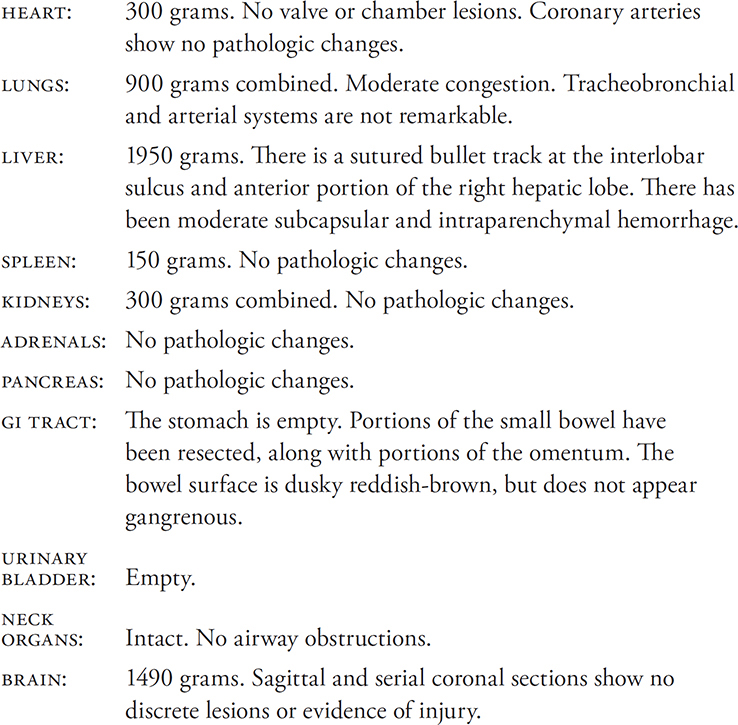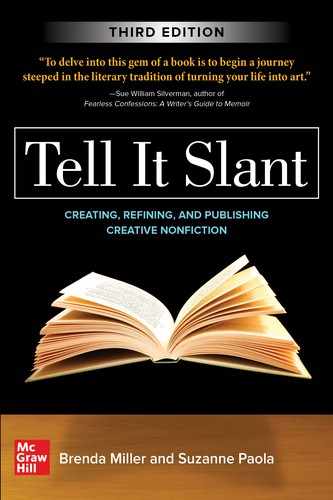9
The Coroner’s Photographs
My brother’s body lies dead and naked on a stainless steel slab. At his head stands a tall arched spigot that, with tap handles mimicking wings, easily suggests a swan in mourning. His head is squarish and overlarge. (This, when he was a toddler, made him seem top-heavy and unsteady on his feet.) His widow’s peak is common among the men in my family, though this one is more dramatic than most. An inverted pyramid, it begins high above the temples and falls steeply to an apex in the boxy forehead, over the heart-shaped face. A triangle into a box over a heart. His eyes (closed here) were big and dark and glittery; they drew you into his sadness when he cried. The lips are ajar as always, but the picture is taken from such an angle that it misses a crucial detail: the left front tooth tucked partly beyond the right one. I need this detail to see my brother full. I paint it in from memory.
A horrendous wound runs the length of the abdomen, from the sternum all the way to the pubic mound. The wound resembles a mouth whose lips are pouting and bloody. Massive staplelike clamps are gouged into these lips at regular intervals along the abdomen. This is a surgeon’s incision. The surgeon was presented with a patient shot six times with a large-caliber handgun. Sensing the carnage that lay within, he achieved the largest possible opening and worked frantically trying to save my brother’s life. He tied off shattered vessels, resectioned the small intestine, repaired a bullet track on the liver, then backed out. The closing would have required two pairs of hands. An assistant would have gripped the two sides of the wound and drawn them together while a second person cut in the clamps. The pulling together has made my brother’s skin into a corset that crushes in on the abdomen from all sides. The pelvic bones jut up through the skin. The back is abnormally arched from the tension. The wound strains at the clamps, threatening to rip itself open. The surgeon worked all night and emerged from surgery gaunt, his greens darkened with sweat. “I tied off everything I could,” he said, and then he wept at the savagery and the waste.
This is the body of Blake Melvin Staples, the seventh of my family’s nine children, the third of my four brothers, born ten years after me. I know his contours well. I bathed and diapered him when he was a baby and studied his features as he grew. He is the smallest of the brothers, but is built in the same manner: short torso but long arms and legs; a more than ample behind set high on the back; knocking knees; big feet that tend to flat. The second toe is also a signature. It curls softly in an extended arc and rises above the others in a way that’s unique to us. His feelings are mine as well. Cold: The sensation moves from my eyes to my shoulder blades to my bare ass as I feel him naked on the steel. I envision the reflex that would run through his body, hear the sharp breath he would draw when steel met his skin. Below the familiar feet a drain awaits the blood that will flow from this autopsy.
The medical examiner took this picture and several on February 13, 1984, at 9:45 A.M. The camera’s flash is visible everywhere: on the pale-green tiles of the surrounding walls, on the gleaming neck of the spigot, on the stainless steel of the slab, on the bloody lips of the wound.
The coroner’s report begins with a terse narrative summary: “The deceased, twenty-two-year-old Negro male, was allegedly shot by another person on the premises of a night club as a result of a ‘long standing quarrel.’ He sustained multiple gunshot wounds of the abdomen and legs and expired during surgery.”
Blake was a drug dealer; he was known for carrying guns and for using them. His killer, Mark McGeorge, was a former customer and cocaine addict. At the trial Mark’s lawyer described the shooting as a gunfight in which Blake was beaten to the draw. This was doubtful. Blake was shot six times: three times in the back. No weapon was found on or near his body. Blake’s gunbearer testified that my brother was unarmed when Mark ambushed and gunned him down. But a gunbearer is not a plausible witness. A drug dealer known for shooting a rival in plain public view gets no sympathy from a jury. The jury turned back the prosecution’s request for a conviction of murder in the first degree. Mark was found guilty of second-degree murder and sentenced to seven years in jail. Five years for the murder. Two years for using the gun.
Blake is said to have cried out for his life as he lay on the ground. “Please don’t shoot me no more. I don’t want to die.” “Please don’t shoot me no more. I don’t want to die.” His voice had a touch of that dullness one hears from the deaf, a result of ear infections he suffered as a child. The ear openings had narrowed to the size of pinholes. He tilted his head woefully from side to side trying to pour out the pain. His vowels were locked high in his throat, behind his nose. This voice kept him a baby to me. This is the voice in which he would have pleaded for his life.
The coroner dissects the body, organ by organ:


The coroner describes the wounds in detail. The surgical incision and its grisly clamps are dismissed in a single sentence. The six bullet holes receive one full paragraph each. The coroner records the angle that each bullet traveled through the body, the organs it passed through along the way, and where it finally came to rest. With all this to occupy him, the coroner fails to note the scar on Blake’s left hand. The scar lies in the webbing between the thumb and index finger and is the result of a gun accident. A shotgun recoiled when Blake fired it and drove the hammer deep into the web, opening a wound that took several stitches to close.
I saw the wound when it was fresh, six weeks before Blake was murdered. I was visiting Roanoke from Chicago, where I then lived. I sought Blake out to tell him that it was time to get out of the business and leave Roanoke. The signs of death were everywhere; his name was hot in the street. Blake and I were making small talk when we slapped each other five. Blake clutched his hand at the wrist and cried out in pain. Then he showed me the stitches. This ended the small talk. I told him that he was in danger of being killed if he didn’t leave town.
Staples men have been monolinguists for generations. We love our own voices too much. Blake responded to my alarm by telling me stories. He told me about the awesome power of the shotgun that had injured him. He told me about making asses of the police when they raided his apartment looking for drugs. The door of his apartment was steel, he said; they’d sent for a tow truck to pull it from its frame. Inside they found him twiddling his thumbs in the bathroom. He’d flushed the cocaine down the toilet. The night he told me these stories was the last time I saw him alive.
Six weeks later my brother Bruce called me with the news. “Brent, Blake is dead,” he said. “Some guy pulled up in a car and emptied out on him with a magnum. Blake is dead.” I told myself to feel nothing. I had already mourned Blake and buried him and was determined not to suffer his death a second time. I skipped the funeral and avoided Roanoke for the next three years. The next time I visited my family I went to see the Roanoke Commonwealth Attorney and questioned him about the case. He was polite and impatient. For him, everything about the killing had been said. This, after all, had been an ordinary death.
I asked to see the files. A secretary brought a manila pouch and handed it to the Commonwealth Attorney, who handed it to me and excused himself from the room. The pouch contained a summary of the trial, the medical examiner’s report, and a separate inner pouch wrapped in twine and shaped like photographs. I opened the pouch; there was Blake dead and on the slab, photographed from several angles. The floor gave way, and I fell down and down for miles.
